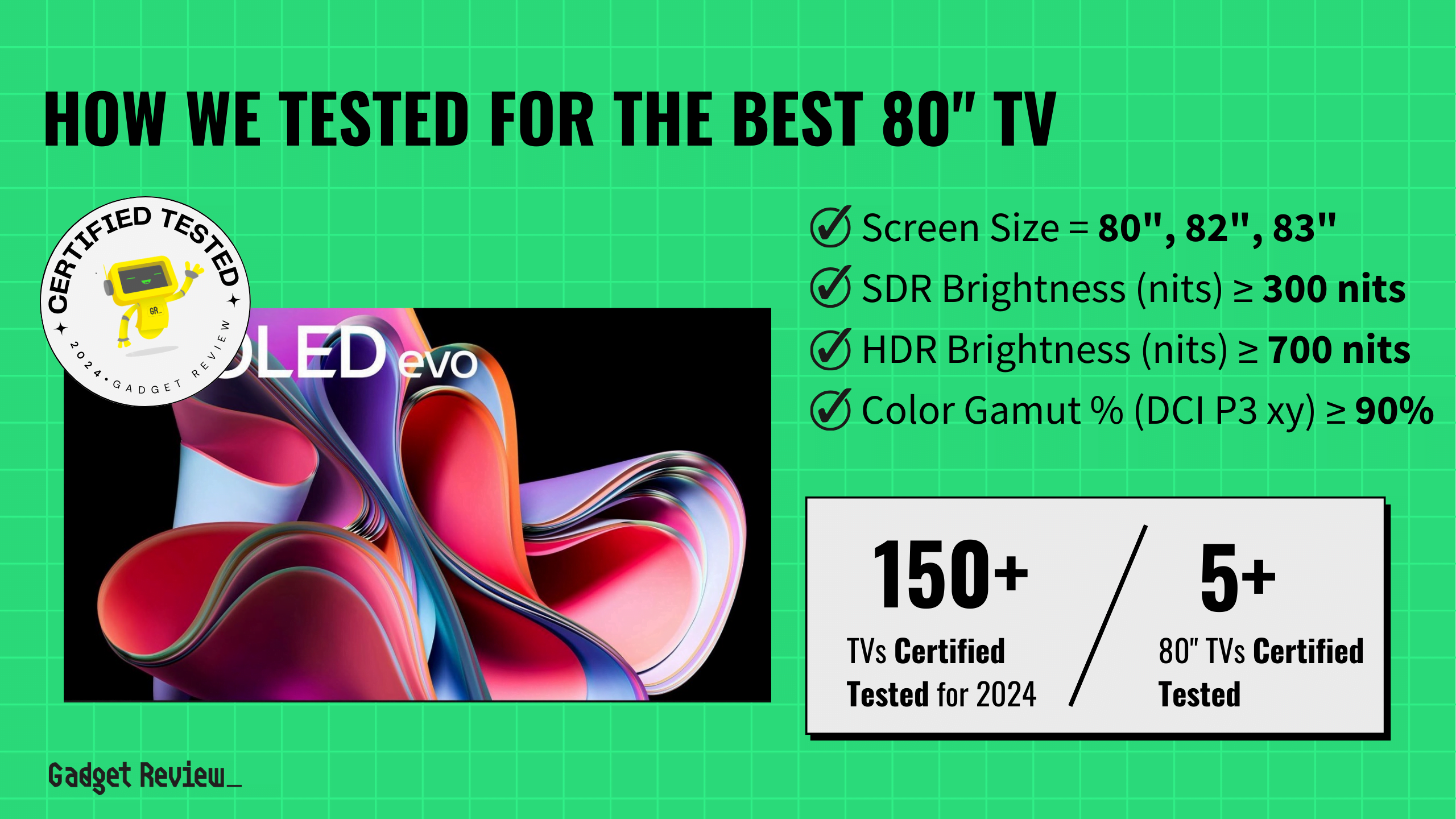The best 80-inch TVs, ideal for movies, games, and sports, come with a variety of options to suit different budgets. Leveraging our comprehensive test data and True Score system, we ensure there’s a top-rated TV for everyone—from budget-conscious viewers to those seeking a premium set.
Our guide makes it simple to find a high-quality 80-inch TV that fits your financial and viewing preferences, ensuring satisfaction across the board.


TL;DR
When you shop through our links, you’re backing our mission.
🎮 Opt for the Samsung S90C over others for top-tier color accuracy, ideal for pro gamers.
🌟 Grab the LG G3 if you want the brightest OLED, perfect for sunny rooms.
🏟️ Choose the TCL QM8 for unmatched brightness, the best for sunlit sports action.
💸 Definitely get the Hisense U8K for top value, more affordable than the LG G3.
How Did We Rank the 80 Inch TVs?
To assess how high or low quality a TV actually is for 80 Inch TVs, one must evaluate specific testing criteria against reference industry standards. Using our thorough TV Testing Methodology, we determined there are 1 minimum specs and 6 criteria below (3 required, 3 nice to have) that ensure your content looks as good as the creator intended it.
Minimum Specifications
- Size: 80 inches, 82 inches, or 83 inches, providing an immersive viewing experience.
Test Criteria
- SDR Brightness: Must meet or exceed 300 nits for optimal visibility in standard lighting conditions.
- HDR Brightness: Must achieve a minimum of 700 nits to display the full range of colors and details in HDR content.
- Color Accuracy: Must cover at least 90% of the DCI P3 color gamut for rich and accurate color reproduction.
“Nice To Haves”
- Contrast Ratio: Preferably greater than or equal to 10,000:1, delivering deep blacks and bright highlights for enhanced image depth and realism.
- EOTF Accuracy: Delta of 0.018 or less for precise brightness and contrast adjustment according to content.
- Fast Response Time: Ideally 10ms or lower, ensuring smooth motion and minimizing motion blur during fast-paced scenes.
We’ve redefined TV buying guides, setting us apart from any other site on the planet. Our unique approach combines in-house verification with a comprehensive dataset from over 200+ trusted sites, focusing on key testing metrics to rank the top-rated 80-inch TVs. Testing data (and specs) include brightness (SDR and HDR), color accuracy, and a set that is 80 inches, 82 inches, or 83 inches. We aggregate and analyze this data from 158+ TVs, ensuring our recommendations meet your specific needs. In this case it’s for 80-inch TVs, delivering exceptional brightness and color accuracy for immersive viewing experiences. Discover our data-driven methodology for precise, reliable TV recommendations. Our commitment to unbiased reviews is powered by our ‘True Score’ system, targeting low quality and fake reviews. Commissions fund this mission. No bias. No BS.
Latest Updates
- 03/5/2024: Completely and thoroughly overhauled the guide to include the best and latest 80 Inch TVs.
- 11/29/2023: Republished the list to include TVs based on our True Score system.
Top 80 Inch TVs For 2025
Prices accurate at the time of publishing
To snag a spot on our list, a 80 Inch TV needs to be a great all around TV that is at least 80-inches in size. If it doesn’t hit these points, we’re not including it!

Best Overall

Runner Up

Best Value

Best Budget

Best Mid-Range

Premium Pick
Samsung S90C TV
With the highest color accuracy (99.98%),refresh rates up to 144 Hz, and superior response (1.4 ms), the Samsung S90C is a dream for gamers and sports fans in bright environments.
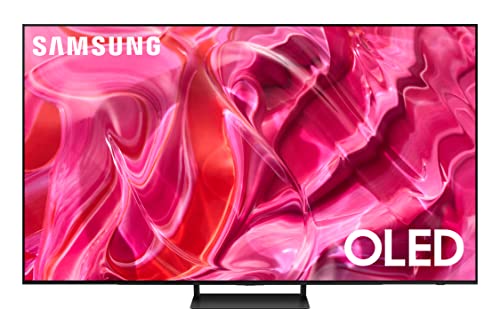
True Score
92938Experts
935kCustomers
Cosmic Wonder
 SAVE $900$3,499.99$2,599.99
SAVE $900$3,499.99$2,599.99Read More
Snapshot
Reasons to Buy
- Excellent picture quality
- The near-infinite contrast ratio for perfect blacks
- High peak brightness
- Exceptionally wide viewing angle
- Low input lag/Response time
- Sharp upscaling
Reasons to Avoid
- Aggressive Auto Brightness Limiter (ABL)
- No support for DTS or Dolby Vision
Specifications
Max Resolution 3840 x 2160 (4k) 
Backlight Type n/a Refresh Rate 120 Hz, 144 Hz Display Type OLED HDMI Inputs 4 
HDMI Type HDMI 2.1 HDR Format HDR10+, HLG 
HomeKit Compatible No 
Number of Audio Channels 2.1 
Panel Type OLED Screen size 55″, 65″, 75″, 83″ 
Smart Platform Tizen 
Speaker Output 40 Watts 
Sync Technology AMD FreeSync Premium 
VRR Yes All Specs
Test Results
SDR Brightness (nits) 373 HDR Brightness (nits) 1,058 Color Gamut % (DCI P3 xy) 99.975 Response Time (ms) 1.4 Contrast Ratio (x:1) 0 EOTF (600 nit delta) 0.0031 Color Gamut % (DCI P3 uv) 99.95 Color Gamut % (Rec 2020 xy) 86.37 Color Gamut % (Rec 2020 uv) 91.59 Color Gamut % (sRGB) 0 Color Gamut % (Rec 709) 0 Color Gamut % (BT.2020) 76 Color Gamut % (Adobe RGB) 0 Color Gamut % (BT.709) 0 Input Lag (ms) 8.5 Color Washout (Degrees) 70 Color Shift (Degrees) 70 Brightness Loss (Degrees) 70 Reflections (%) 1.2 Low-Freq Extension (Hz) 84.76 Freq Response StdDev @ 70db 2.8 Freq Response StdDev @ 80db 3.63 Weighted Total Harmonic Distortion @80db 0.133 Intermodulation Distortion @80db 2.47 EOTF (1000 nit delta) 0.0036 EOTF (4000 nit delta) 0.0024 All Tests
All Retailers
- $2,599.99$3,500Save $900
Availability
In StockFree Shipping
No - $2,999.00
Availability
In StockFree Shipping
No - $3,297.99$5,398Save $2
Availability
In StockFree Shipping
- $5,399.00
Availability
In StockFree Shipping
Yes
Our Verdict
If you’re looking for vibrant colors when gaming in an OLED that’s friendlier to your wallet, the Samsung S90C TV brings excellent performance at a surprising price. Featuring a best-in-class color gamut coverage of 99.98% in the DCI P3 xy space, colors are rendered with unparalleled accuracy and vibrancy. This is complemented by a peak SDR and HDR brightness of 373 nits and 1058 nits respectively, which guarantees that HDR content is displayed with striking contrast and brightness levels.
The TV also boasts a refresh rate that goes beyond the standard 120 Hz, reaching up to 144 Hz, which is particularly beneficial for gaming and watching fast-action scenes with minimal motion blur. The response time of 1.4 ms is best in its class, and further helps with performance during high intensity moments by significantly reducing ghosting and enhancing the clarity of moving images. Coupled with its best-in-class input lag of 8.5 ms, the S90C is a standout choice for gamers and sports fans looking for the smoothest, most responsive experience possible.
Overall, the S90C shines in delivering an exceptional viewing experience through its nearly perfect color accuracy, high refresh rate, and quick response time. It’s let down only by its lower brightness than the G3 and inferior EOTF, but it can still handle a bright room rather well, and while it won’t track gamma as accurately as the G3, it’s still the second best TV on the list. If you’re a gamer or sports fan looking for the best possible experience and don’t mind paying the OLED premium, the S90C is absolutely the way to go.
Read Less
Category Snapshot
TVs
- Total Brands/Products Tested
17 Brands, 158 Products
- Top 2 Brands
LG, Hisense
- Price Range (Budget-Premium)
$400-$2000
- Average True Score
76.65
- Important Test Criteria
Brightness (cd/m2)
Contrast Ratio (1000:1) - Most Trusted Testers

- Top TV Experts
- Recommended Retailer

- Typical Warranty
1 year
- Covered by Insurance
Yes – AKKO
- Test Methodology

Best Overall

Runner Up

Best Value

Best Budget

Best Mid-Range

Premium Pick
LG G3 OLED TV
The LG G3 OLED TV redefines the 80-inch category with outstanding color gamut and unmatched OLED peak brightness, perfect for bright rooms and delivering unparalleled viewing experiences.
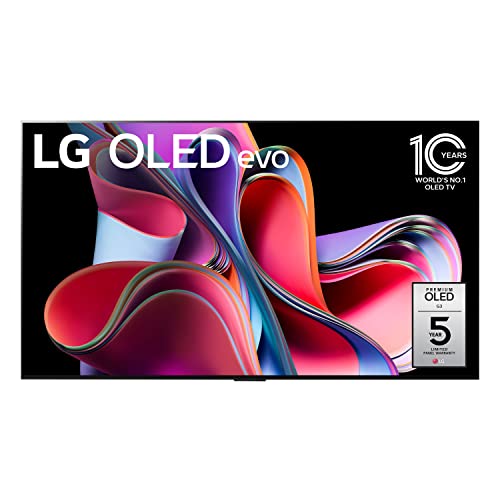
True Score
919315Experts
922kCustomers
Cosmic Wonder
 $2,996.99
$2,996.99Read More
Snapshot
Reasons to Buy
- Excellent picture quality
- Near-infinite contrast ratio resulting in perfect blacks
- Extremely bright for an OLED
- Fast motion handling
- Exceptionally wide viewing angle
Reasons to Avoid
- Aggressive automatic brightness limiter
- Subpar sound quality
Specifications
Max Resolution 3840 x 2160 (4k) 
Backlight Type n/a Refresh Rate 120 Hz Display Type OLED HDMI Inputs 4 
HDMI Type HDMI 2.1 HDR Format Dolby Vision, HDR10, HLG 
HomeKit Compatible Yes 
Number of Audio Channels 4.2 
Panel Type OLED Screen size 55″, 65″, 77″, 83″ 
Smart Platform webOS 
Speaker Output 60 watts 
Sync Technology G-Sync 
VRR Yes All Specs
Test Results
SDR Brightness (nits) 503 HDR Brightness (nits) 1,385 Color Gamut % (DCI P3 xy) 97.5457 Response Time (ms) 2.6 Contrast Ratio (x:1) 0 EOTF (600 nit delta) 0.0027 Color Gamut % (DCI P3 uv) 99.13 Color Gamut % (Rec 2020 xy) 73.65 Color Gamut % (Rec 2020 uv) 75.48 Color Gamut % (sRGB) 100 Color Gamut % (Rec 709) 99.7631 Color Gamut % (BT.2020) 74.4 Color Gamut % (Adobe RGB) 94 Color Gamut % (BT.709) 0 Input Lag (ms) 11.8 Color Washout (Degrees) 70 Color Shift (Degrees) 70 Brightness Loss (Degrees) 70 Reflections (%) 0.9 Low-Freq Extension (Hz) 89.8 Freq Response StdDev @ 70db 2.01 Freq Response StdDev @ 80db 2 Weighted Total Harmonic Distortion @80db 0.143 Intermodulation Distortion @80db 1.4 EOTF (1000 nit delta) 0.0039 EOTF (4000 nit delta) 0.0036 All Tests
All Retailers
- $2,996.99
Availability
In StockFree Shipping
No - $3,150.00$6,500Save $3,350
Availability
In StockFree Shipping
No - $4,696.99$6,497Save $1
Availability
In StockFree Shipping
Our Verdict
As one of the top spots on our list, the LG G3 OLED TV sets an impressive benchmark for excellence in the 80-inch TV category with excellent all-around performance. Its 97.55% color gamut coverage in the DCI P3 xy space means it features rich colors that are backed up by the highest brightness for SDR and HDR among the OLEDs on our list. Clocking in at 503 nits and 1385 nits for SDR and HDR, respectively, the G3 is bright enough to be used in bright rooms without fear of the light ruining the picture quality.
With a refresh rate of 120 Hz and support for HDMI 2.1, the G3 is future-proofed for gaming enthusiasts and sports fans, and is further helped by its excellent response time of 2.6 ms, ensuring that the picture remains free of motion blur. While the input lag isn’t the best at 11.8 ms, it’s still enough for casual and competitive gaming alike. The low reflectivity (0.9% total reflected light) of the screen and good brightness also means that the G3 is an excellent candidate for sports fans that have their TVs in brighter rooms or gamers that have to deal with lots of natural light in the game room.
The G3 is a uniquely positioned television. It’s very expensive – the most expensive on the list, but it brings unparalleled brightness for an OLED and features exceptional EOTF. At 0.0027, it’s the most accurate 80-inch television when it comes to gamma, meaning that home theater enthusiasts will enjoy near perfect replication of the mastering of their favorite films. If you need a large centerpiece television for a room that’s full of natural light and want the infinite contrast and pure blacks of OLED panels, the G3 is an excellent – but pricey – choice.
Read Less

Best Overall

Runner Up

Best Value

Best Budget

Best Mid-Range

Premium Pick
TCL QM8/QM850G QLED TV
For those prioritizing sports in sunlit rooms, the TCL QM8 excels with the highest brightness (SDR: 2076 nits, HDR: 2005 nits) and good motion handling (8.9 ms response), offering incredible value and versatility for every viewing need, especially sports.
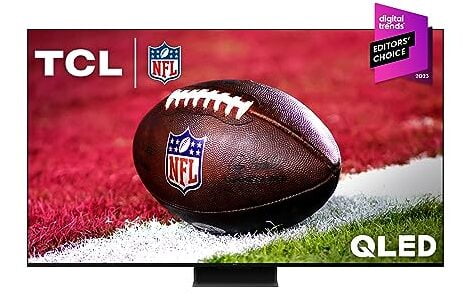
True Score
85837Experts
90488Customers
Absolutely Fresh
 $1,498.00
$1,498.00Read More
Snapshot
Reasons to Buy
- Outstanding picture quality
- Spectacular brightness and contrast ratio
- Rapid response time
- Super low input lag
Reasons to Avoid
- Disappointing viewing angles
Specifications
Max Resolution 3840 x 2160 (4k) 
Backlight Type Full-Array Refresh Rate 120 Hz 
Depth 11.7″ Display Type QLED HDMI Inputs (Total) 2 
HDMI Type HDMI 2.1 HDR Format Dolby Vision, HDR10, HDR10+, HLG 
Height 34.1″ High Dynamic Range (HDR) Yes 
Number of Audio Channels 3 
Panel Type LED Screen size 65″, 75″, 85″, 98″ 
Smart Platform Google TV 
Speaker Output 40 Watts 
Sync Technology AMD FreeSync Premium Pro 
VRR Yes 
Voice Assistant Google Assistant 
Weight 54.7 lbs 
Width 56.9″ 
Works With Amazon Alexa, Apple HomeKit, Google Assistant All Specs
Test Results
SDR Brightness (nits) 2,076 HDR Brightness (nits) 2,005 Color Gamut % (DCI P3 xy) 94.59 Response Time (ms) 8.9 Contrast Ratio (x:1) 114,057 EOTF (600 nit delta) 0.037 Color Gamut % (DCI P3 uv) 97.31 Color Gamut % (Rec 2020 xy) 75.81 Color Gamut % (Rec 2020 uv) 80.57 Color Gamut % (sRGB) 0 Color Gamut % (Rec 709) 0 Color Gamut % (BT.2020) 0 Color Gamut % (Adobe RGB) 0 Color Gamut % (BT.709) 0 Input Lag (ms) 14.3 Color Washout (Degrees) 24 Color Shift (Degrees) 31 Brightness Loss (Degrees) 32 Reflections (%) 1.8 Low-Freq Extension (Hz) 89.8 Freq Response StdDev @ 70db 4.74 Freq Response StdDev @ 80db 4.67 Weighted Total Harmonic Distortion @80db 0.128 Intermodulation Distortion @80db 8.67 EOTF (1000 nit delta) 0.0238 EOTF (4000 nit delta) 0.0271 All Tests
All Retailers
- $1,498.00
Availability
In StockFree Shipping
No - $1,614.99$1,700Save $85
Availability
In StockFree Shipping
No - $1,649.99
Availability
In StockFree Shipping
No
Our Verdict
If you’re looking for big screen sports action on a budget and you’ve got to put your TV in an extremely well-lit room, The TCL QM8 is an excellent value pick. It’s impressive response time of 8.9 ms makes it ideal for minimizing motion blur and ghosting when the action on screens gets fast. This pairs well with its 120 Hz refresh rate, and while it supports HDMI 2.1, the 14.3 ms of input lag puts the QM8 at the back of the pack when it comes to responsive gaming. It’ll get the job done, especially in a very bright room, but better options exist.
While the Hisense U8K features superior color accuracy, the 94.59% color gamut coverage of the TCL QM8 pairs well with an HDR brightness peaking at 2005 nits and SDR brightness at 2076 nits. This level of brightness is unparalleled, making it the best possible choice for any kind of content in rooms full of natural sunlight. Plus, wiith a reflectivity of 1.8%, glare is kept to a minimum to keep the picture clear.
Overall, the TCL QM850G is priced similarly to the U8K – in fact it’s only a few dollars more expensive. But much like the U8K is more specialized for home theater content, the TCL QM8 is the best pick for bright rooms and sports without paying the OLED premium and still getting excellent overall quality, as well as enough versatility to watch movies and play casual games.
Read Less

Best Overall

Runner Up

Best Value

Best Budget

Best Mid-Range

Premium Pick
Hisense U8K TV
The Hisense U8K boasts a bright display and solid color accuracy as well as EOTF tracking, making it an unbeatable budget choice for brightly lit home theaters.
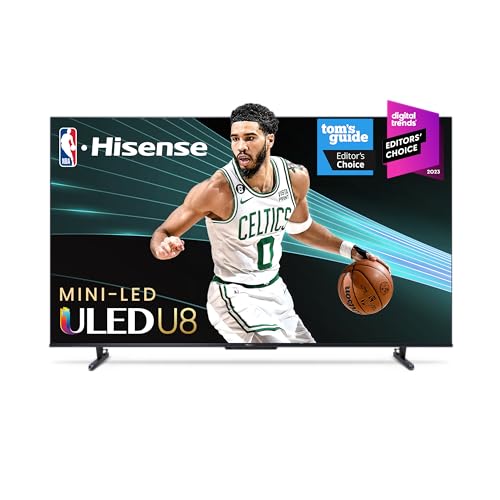
True Score
80806Experts
831kCustomers
Absolutely Fresh
 SAVE $110$2,199.99$2,089.99
SAVE $110$2,199.99$2,089.99Read More
Snapshot
Reasons to Buy
- Good picture quality
- Outstanding brightness and good contrast ratio
- Quick response time
- Great reflection handling
Reasons to Avoid
- Poor viewing angles
Specifications
Max Resolution 3840 x 2160 (4k) 
Backlight Type Full-Array Refresh Rate 144 Hz 
Depth 3″ Display Type LED HDMI Inputs (Total) 4 
HDMI Type HDMI 2.1 HDR Format Dolby Vision, HDR10, HDR10+, HLG 
Height 33.1″ High Dynamic Range (HDR) Yes 
Number of Audio Channels 2.1.2 
Panel Type VA Screen size 100″, 55″, 65″, 75″, 85″ 
Smart Platform Google TV 
Speaker Output 50 Watts 
Voice Assistant Google Assistant 
Weight 56.4″ lbs 
Width 57.2″ 
Works With Google Assistant All Specs
Test Results
SDR Brightness (nits) 1,549 HDR Brightness (nits) 1,792 Color Gamut % (DCI P3 xy) 97.44 Response Time (ms) 13.3 Contrast Ratio (x:1) 165,360 EOTF (600 nit delta) 0.0105 Color Gamut % (DCI P3 uv) 97.01 Color Gamut % (Rec 2020 xy) 76.18 Color Gamut % (Rec 2020 uv) 81.82 Color Gamut % (sRGB) 0 Color Gamut % (Rec 709) 0 Color Gamut % (BT.2020) 80 Color Gamut % (Adobe RGB) 0 Color Gamut % (BT.709) 0 Input Lag (ms) 14.2 Color Washout (Degrees) 23 Color Shift (Degrees) 23 Brightness Loss (Degrees) 35 Reflections (%) 1.8 Low-Freq Extension (Hz) 80 Freq Response StdDev @ 70db 2.06 Freq Response StdDev @ 80db 2.11 Weighted Total Harmonic Distortion @80db 0.1 Intermodulation Distortion @80db 0.71 EOTF (1000 nit delta) 0.0106 EOTF (4000 nit delta) 0.011 All Tests
All Retailers
- $2,089.99$2,200Save $110
Availability
In StockFree Shipping
No - $3,099.00
Availability
In StockFree Shipping
No Availability
Free Shipping
Our Verdict
If you’re a gamer looking for a more budget 80-inch option, the Hisense U8K offers up a unique blend of value and performance that make it one of the Best Value TVs you can buy. Thanks to the TV’s exceptional SDR and HDR brightness levels, peaking at 1549 and 1792 nits, the U8K is a fantastic option for anyone that needs a TV that can work in a bright room without being overcome by the light. Plus, with an EOTF of 0.0105, it has good enough gamma tracking to be an excellent option for home theater aficionados.
Its 97.44% color gamut coverage in the DCI P3 xy space is excellent, guaranteeing vibrant and accurate colors, especially in games. This high accuracy pairs well with the 144 Hz refresh rate and great brightness levels, making it an ideal choice for viewers seeking a bright and fluid viewing experience. Additionally, the U8K’s input lag 14.2 ms, while not the fastest, is still great for enjoying vivid visuals in casual games.
The contrast ratio of 165360:1 further enhances the experience, and gives the U8K the ability to produce deep blacks and bright whites, further enhancing the depth and realism of images, even if it can’t compete with the infinite contrast of OLED panels.
The Hisense U8K TV is a versatile choice for a variety of settings, but is best suited for a home theater, be it dim or brightly lit. Great brightness, great color accuracy and good EOTF tracking, coupled with best-in-class value make it the ideal choice for cinephiles on a budget that still want a big TV for their home.
Read Less

Our Approach to Testing 80 Inch TVs
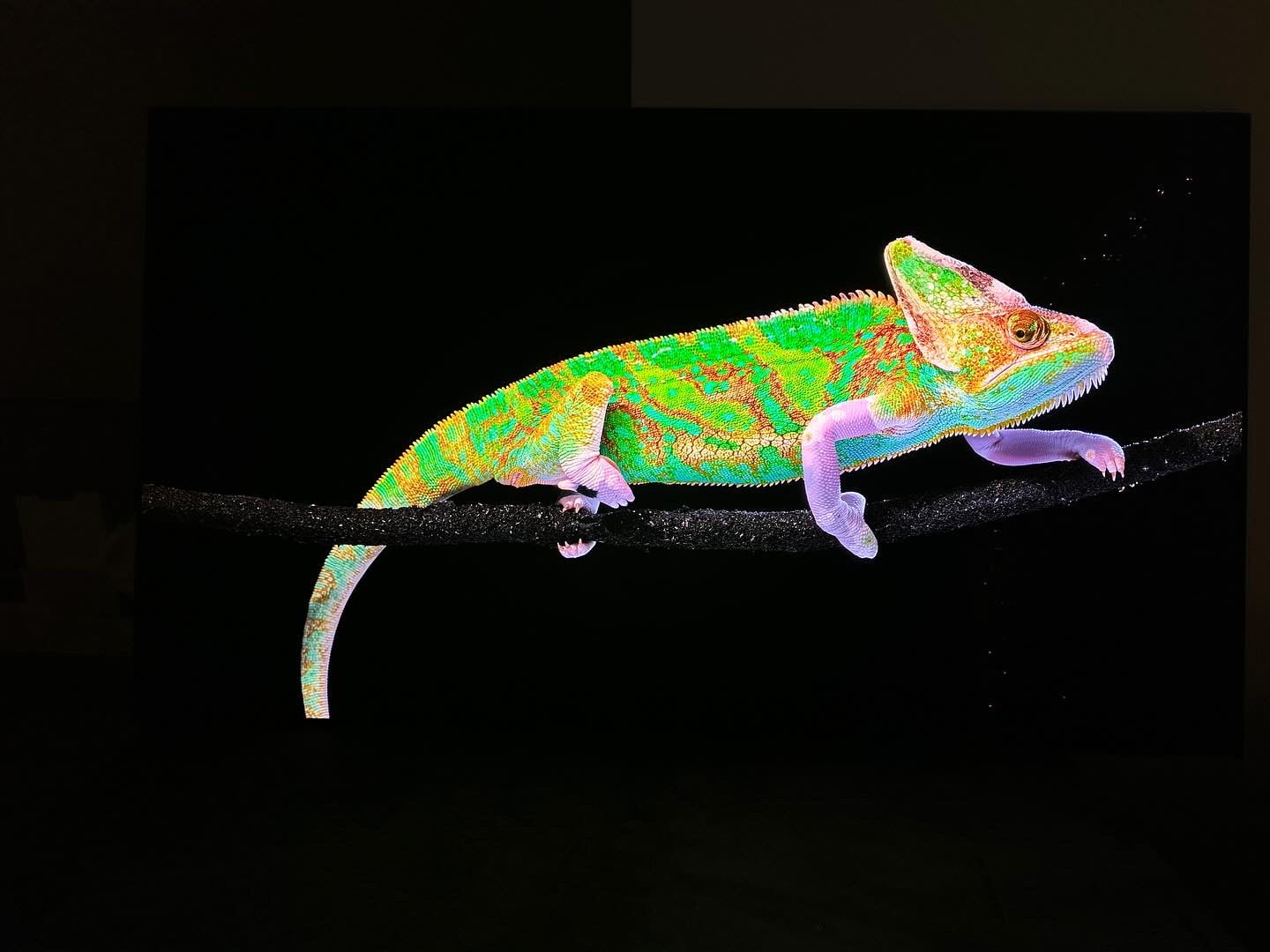
Evan Shepard/Gadget Review
We’ve redefined TV buying guides, setting us apart from any other site on the planet. Our unique approach combines in-house verification with a comprehensive dataset from trusted sites, focusing on key testing metrics like brightness (SDR and HDR), EOTF, response time, contrast ratio and color gamut.
The best 80-inch TV strikes a balance between stunning resolution and seamless viewing experience. It’s crucial to find one that delivers crisp images, smooth motion handling, and robust HDR support for vibrant visuals. Look for features like a high refresh rate, low input lag, and intuitive streaming interface to enhance your entertainment. Need more guidance? Let’s explore the specifics together.
You may notice some of our graphs contain “Source: RTings”. This is to indicate that the data we’re showing off in a graph has come from a single source – because it’s the only source that actually tested the criteria and had data for it! Normally, our data is an average out of all of the various publications that test and provide data to give you a good idea of how a product is going to perform on average.
Which Criteria Matters for Testing 80-Inch TVs?
By focusing on these criteria (3 required, 3 nice to have), anyone can quickly and easily compare these TVs and how they’ll perform. This helps you make an informed decision and purchase the best 80 inch TV.
| CRITERIA | RANGE | REQUIRED | DEFINITION |
|---|---|---|---|
| SDR Brightness | 300+ nits | Yes | Assess the luminance of your display when operating in Standard Dynamic Range (SDR) mode. |
| HDR Brightness | 700+ nits | Yes | Determine the luminance of your display in High Dynamic Range (HDR) mode. |
| Color Gamut (DCI P3 xy) | >= 90% | Yes | Evaluate the extent to which a TV can reproduce a specified spectrum of colors. |
| EOTF | 0.018 | No (nice to have) | Standard that governs how a display interprets and renders brightness and color. |
| Response Time | <=10ms | No (nice to have) | Time required for a pixel to transition from one color to another and then return to its original color. |
| Contrast Ratio | >= 10,000 | No (nice to have) | The ratio between the brightest white and darkest black that the screen can display. |
Our Trusted Data Sources
(Publication category Score is 80%+)
We looked at 210+ TV reviewers and while 24 are trustworthy (60%+ Trust Rating), we only use data from the testers that are “very trusted” which means a Trust Rating above 70%. The three we have listed below are our most trusted for TVs, along with our own in-house TV expert.
- Evan Shepard – Gadget Review
- Matthew Lopes – RTings, MuckRack
- Will Greenwald – PCMag, MuckRack, Twitter
- David Katzmaier – CNET, MuckRack, Twitter
Interested in a comprehensive analysis of our data sources? We’ve got you covered. Below, you’ll find a detailed list of every TV review website we’ve identified, organized by their respective Trust Ratings from highest to lowest. But we didn’t stop there. We’ve meticulously reviewed each publication and verified the data by checking whether the authors have bio links to MuckRack or LinkedIn. We’re committed to not only checking the facts but ensuring their veracity.
TV Test Data & Results
1. SDR & HDR Brightness TV Test Results
In well-lit rooms, the brightness level of your 80 Inch TV, quantified in nits, is key to a great viewing experience. A TV that doesn’t meet the brightness requirement will struggle against natural and artificial light, resulting in a dim, lackluster image. Essentially, nits measure how well your TV can stand up to light interference, with higher values ensuring a sharper, more vivid display.
For standard viewing on the best 80 Inch TV, you should look for at least 300 nits to strike the right balance between clarity and color quality in standard dynamic range (SDR) content. For high dynamic range (HDR) content, which offers richer colors and greater contrast, a minimum of 700 nits is ideal to truly appreciate the enhanced visuals. These brightness levels are recommended to ensure your TV performs well in bright settings, allowing you to enjoy your shows and movies without any loss in detail or quality. Aim for these minimums: SDR Brightness >= 300 nits; HDR Brightness >= 700 nits for the optimal experience.
Discover the top 80 Inch TVs, ranked from brightest to least, all exceeding our brightness criteria.
Brightness
SDR: 300+ nits
HDR: 700+ nits
Acceptable range of performance
Definition: Maximum brightness in a specified pattern size window. Most commonly measured in a 10% or 100% white window.
Units of Measurement: nits (alternatively cd/m²)
Tools to Measure: TV, luminance meter
Why It’s Important:
Brightness helps counter ambient light so that details and colors don’t wash out and get lost.
SDR Brightness (in nits, higher is better)
HDR Brightness (in nits, higher is better)
2. Color Gamut (DCI P3 xy) TV Test Results
Color Gamut
>= 90%
Acceptable range of performance
Definition: The TV’s capability to display a spectrum of colors.
Units of Measurement: % (color space coverage in percent)
Tools to Measure: Colorimeter
Why It’s Important:
Inaccurate colors compromise the authenticity of the content.
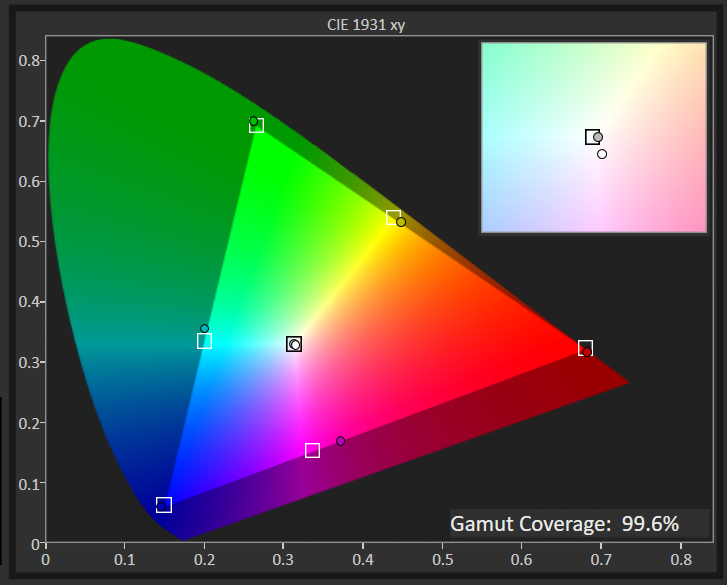
Color gamut defines the range of colors an 80-inch TV can reproduce, directly affecting how vibrant and true-to-life the images look. A wide color gamut in a compact TV such as a top-rated 40-inch TV brings out richer, more vivid colors – from the lush greens of a garden to the bright colors of animated characters, enhancing your viewing experience to closely mimic real life.
This concept is technically measured against standards like the DCI P3 xy, a benchmark for high-quality visuals. A 80 Inch TV covering a higher percentage of this color space can display colors more accurately and vividly.
For those who prioritize vibrant and immersive visuals, aiming for a 80 Inch TV with a color gamut of 90% or higher on the DCI P3 xy scale is ideal. This ensures that the content you watch is as vibrant and lifelike as possible. Below is all the TVs on this guide sorted by best to least in Color Gamut.
Below are the top 80 Inch TVs, ordered by color gamut, all exceeding our testing criteria.
DCI P3 XY Color Gamut (as a %; high is better)
3. EOTF Test Results
The Electro-Optical Transfer Function (EOTF) plays a critical role in ensuring the content on your TV looks exactly as the creator intended. This technical feature adjusts your screen’s brightness levels, ensuring every scene, from the darkest shadows to the brightest highlights, is displayed with true-to-life accuracy.
In rooms flooded with light, a TV that nails EOTF calibration shines by preserving the intended contrast and detail in the picture despite the challenging conditions. It balances the brightness so that images remain vibrant and full of detail, unaffected by the glare of ambient light.
A TV that excels in managing EOTF offers an immersive and authentic viewing experience. It brings creators’ visions to life, accurately rendering every scene with the proper light and dark levels, no matter the lighting in your room. This means you get a consistent, realistic picture that captures the full spectrum of colors and contrasts, from the subtlest hues to the most intense explosions. Below is all the TVs on this guide sorted from best to worst in EOTF.
Below are all the 80 Inch TVs on our list, ordered by EOTF.
EOTF
< 0.018 (600 nit Δ)
Acceptable range of performance
Definition: How your TV interprets and renders the luminance data from content and translates it to be represented on screen. If EOTF/Gamma tracking is too low or too high, it will result in an over-brightened or over-darkened image from reference.
Units of Measurement: this test measures for the delta from the standard
Tools to Measure: Luminance colorimeter
Why It’s Important:
EOTF ensures that the game is displayed (color and HDR brightness) as the creator intended it
EOTF (source: rtings.com – 0 = no data exists; lower is better)
4. Response Time TV Test Results
Response Time
1ms-10ms
Acceptable range of performance
Definition: Speed at which a pixel transitions from one color to another
Units of Measurement: milliseconds (ms)
Tools to Measure: Screen, camera, test software
Why It’s Important:
A faster response time means less blur and thus more accuracy
A slow response time on a 80 Inch TV during fast-paced scenes is like trying to watch a thrilling movie with a foggy lens. Imagine settling in for an action-packed sequence, only to have the swift movements turn into a blur, robbing you of the crisp, clear detail you crave. This isn’t just a minor annoyance; it’s a major detriment to your viewing experience, leaving you with a picture marred by motion blur and visual artifacts.
So, what exactly is response time? It measures how quickly a pixel on your TV can change from one color to another. In the context of watching fast-moving content or enjoying dynamic scenes on a 80 Inch TV, a low response time is crucial. A response time of 15 ms or lower is good, but if you plan on gaming on this set, aim for a response time of 10 ms or lower. At these levels, your 80 Inch TV ensures smooth transitions and sharp visuals, making every scene come to life without any distracting blurs or delays.
Below are the top 80 Inch TVs, ordered by response time.
Response Time (in milliseconds; lower is better)
5. Contrast Ratio Test Results
For 80 Inch TV enthusiasts, a solid contrast ratio is crucial for enjoying your favorite TV shows or movies, especially in darker settings. This feature directly impacts how lifelike and dynamic the picture appears on your screen, ensuring that dark scenes are displayed with clear, crisp blacks instead of murky grays and bright scenes retain their detail without appearing washed out.
Put simply, the contrast ratio is all about the range of luminance a TV can produce, from the deepest blacks to the brightest whites. It’s what brings depth to the image, enhancing the realism of every scene. Watching a movie in the dark, for example, the difference between a TV with a poor contrast ratio and one with a high ratio is stark: the former struggles, blending shadows into a flat gray, while the latter delivers true black, making night scenes more immersive and detailed.
Ideally, a contrast ratio of 10,000:1 is what you should aim for in a 80 Inch TV. This level of luminance variance ensures that you’re getting a picture quality that can handle the nuances of lighting in any scene, providing a viewing experience that’s both rich and engaging. Note: OLED TVs have infinite contrast ratio, indicated by “0.”
Below are the top 80 Inch TVs, ordered by contrast ratio, all exceeding our testing criteria.
Contrast Ratio
>=10,000:1
Acceptable range of performance
Definition: Difference between the darkest black and the brightest white a screen can display.
Units of Measurement: cd/m2
Tools to Measure: Luminance meter
Why It’s Important:
A higher contrast ratio delivers deeper blacks, enhancing content definition, especially in darker rooms.
Contrast Ratio (higher is better)
80 Inch TVs: Mistakes To Avoid
- Not measuring the space: Failing to choose the right TV size for your space can lead to purchasing a TV that’s too large for the room or doesn’t fit properly within the entertainment area. If something as large as the best 75 inch TVs are too large for your space, consider either the top 55″ or top 65″ TVs instead, which have become the most popular size range of TVs today and might be a more comfortable option.
- Ignoring viewing distance: Not considering the recommended viewing distance for an 80-inch TV can result in discomfort while watching, such as having to crane the neck or strain the eyes. Proper viewing distance improves the TV’s ease of use, which is important not only for the physical setup but also for the TV’s operating system. For example, choosing between a top-rated Roku TV and the best Android TV can affect your viewing experience. Roku TVs offer a straightforward interface for easy navigation, and Android TVs provide customizable experiences and Google Assistant for voice commands.
- Overlooking resolution: Assuming that a larger screen automatically means better picture quality can lead to overlooking the importance of resolution. It’s crucial to ensure the TV’s resolution (e.g., 4K or 8K) matches the screen size for optimal clarity. If you are looking at the best 8K TVs, it’s not just about the size but also how the higher resolution can enhance the viewing experience, especially on larger screens. When considering 4K vs 8K, it’s important to understand their differences, and the choice should depend on the content availability and the viewing environment.
- Disregarding picture quality: Simply focusing on the size of the TV and overlooking factors like brightness, contrast ratio, color accuracy, and HDR capability can result in a subpar viewing experience. Check out our guide on the best OLED TVs, as OLED technology is renowned for its exceptional contrast ratios and color accuracy, enhancing the overall quality of the picture.
The 80 Inch TV’s Tests Compared
Product |
True Score
|
SDR Brightness
|
HDR Barightness
|
Color Gamut
|
EOTF
|
Response Time
|
Contrast Ratio
| |
|---|---|---|---|---|---|---|---|---|
| 92 |
|
|
|
|
|
| $2,599.99 $3,500 $900 |
| 91 |
|
|
|
|
|
| $2,996.99 |
| 85 |
|
|
|
|
|
| $1,498.00 |
| 80 |
|
|
|
|
|
| $2,089.99 $2,200 $110 |


